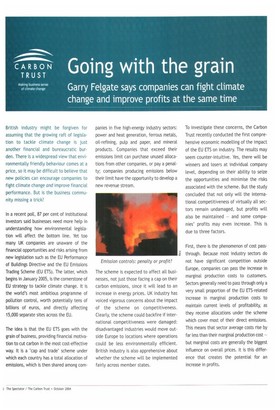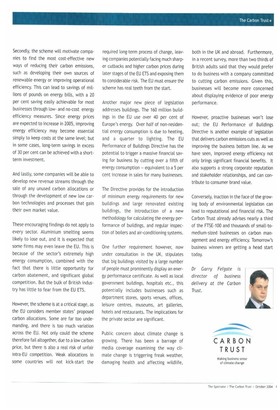Going with the grain
Garry Felgate says companies can fight climate change and improve profits at the same time
British industry might be forgiven for assuming that the growing raft of legislation to tackle climate change is just another financial and bureaucratic burden. There is a widespread view that environmentally friendly behaviour comes at a price, so it may be difficult to believe that new policies can encourage companies to fight climate change and improve financial performance. But is the business community missing a trick?
In a recent poll, 87 per cent of institutional investors said businesses need more help in understanding how environmental legislation will affect the bottom line. Yet too many UK companies are unaware of the financial opportunities and risks arising from new legislation such as the EU Performance of Buildings Directive and the EU Emissions Trading Scheme (EU ETS). The latter, which begins in January 2005, is the cornerstone of EU strategy to tackle climate change. It is the world's most ambitious programme of pollution control, worth potentially tens of billions of euros, and directly affecting 15,000 separate sites across the EU.
The idea is that the EU ETS goes with the grain of business, providing financial motivation to cut carbon in the most cost-effective way. It is a 'cap and trade' scheme under which each country has a total allocation of emissions, which is then shared among corn panies in five high-energy industry sectors: power and heat generation, ferrous metals, oil-refining, pulp and paper, and mineral products. Companies that exceed their emissions limit can purchase unused allocations from other companies, or pay a penalty; companies producing emissions below their limit have the opportunity to develop a new revenue stream.
The scheme is expected to affect all businesses, not just those facing a cap on their carbon emissions, since it will lead to an increase in energy prices. UK industry has voiced vigorous concerns about the impact of the scheme on competitiveness. Clearly, the scheme could backfire if international competitiveness were damaged: disadvantaged industries would move outside Europe to locations where operations could be less environmentally efficient. British industry is also apprehensive about whether the scheme will be implemented fairly across member states. To investigate these concerns, the Carbon Trust recently conducted the first comprehensive economic modelling of the impact of the EU ETS on industry. The results may seem counter-intuitive. Yes, there will be winners and losers at individual company level, depending on their ability to seize the opportunities and minimise the risks associated with the scheme. But the study concluded that not only will the international competitiveness of virtually all sectors remain undamaged, but profits will
also be maintained and some companies' profits may even increase. This is due to three factors.
First, there is the phenomenon of cost passthrough. Because most industry sectors do not have significant competition outside Europe, companies can pass the increase in marginal production costs to customers. Sectors generally need to pass through only a very small proportion of the EU ETS-related increase in marginal production costs to maintain current levels of profitability, as they receive allocations under the scheme which cover most of their direct emissions. This means that sector average costs rise by far less than their marginal production cost — but marginal costs are generally the biggest influence on overall prices. It is this difference that creates the potential for an increase in profits. Secondly, the scheme will motivate companies to find the most cost-effective new ways of reducing their carbon emissions, such as developing their own sources of renewable energy or improving operational efficiency. This can lead to savings of millions of pounds on energy bills, with a 20 per cent saving easily achievable for most businesses through lowand no-cost energy efficiency measures. Since energy prices are expected to increase in 2005, improving energy efficiency may become essential simply to keep costs at the same level; but in some cases, long-term savings in excess of 30 per cent can be achieved with a shortterm investment.
And lastly, some companies will be able to develop new revenue streams through the sale of any unused carbon allocations or through the development of new low carbon technologies and processes that gain their own market value.
These encouraging findings do not apply to every sector. Aluminium smelting seems Likely to lose out, and it is expected that some firms may even leave the EU. This is because of the sector's extremely high energy consumption, combined with the fact that there is little opportunity for carbon abatement, and significant global competition. But the bulk of British industry has little to fear from the EU ETS.
However, the scheme is at a critical stage, as the EU considers member states' proposed carbon allocations. Some are far too undemanding, and there is too much variation across the EU. Not only could the scheme therefore fail altogether, due to a low carbon price, but there is also a real risk of unfair intra-EU competition. Weak allocations in some countries will not kick-start the required long-term process of change, leaving companies potentially facing much sharper cutbacks and higher carbon prices during later stages of the EU ETS and exposing them to considerable risk. The EU must ensure the scheme has real teeth from the start.
Another major new piece of legislation addresses buildings. The 160 million buildings in the EU use over 40 per cent of Europe's energy. Over half of non-residential energy consumption is due to heating, and a quarter to lighting. The EU Performance of Buildings Directive has the potential to trigger a massive financial saving for business by cutting over a fifth of energy consumption — equivalent to a 5 per cent increase in sales for many businesses.
The Directive provides for the introduction of minimum energy requirements for new buildings and large renovated existing buildings, the introduction of a new methodology for calculating the energy performance of buildings, and regular inspection of boilers and air-conditioning systems.
One further requirement however, now under consultation in the UK, stipulates that big buildings visited by a large number of people must prominently display an energy performance certificate. As well as local government buildings, hospitals etc., this potentially includes businesses such as department stores, sports venues, offices, leisure centres, museums, art galleries, hotels and restaurants. The implications for the private sector are significant.
Public concern about climate change is growing. There has been a barrage of media coverage examining the way climate change is triggering freak weather, damaging health and affecting wildlife, both in the UK and abroad. Furthermore, in a recent survey, more than two thirds of British adults said that they would prefer to do business with a company committed to cutting carbon emissions. Given this, businesses will become more concerned about displaying evidence of poor energy performance.
However, proactive businesses won't lose out; the EU Performance of Buildings Directive is another example of legislation that delivers carbon emissions cuts as well as improving the business bottom line. As we have seen, improved energy efficiency not only brings significant financial benefits. It also supports a strong corporate reputation and stakeholder relationships, and can contribute to consumer brand value.
Conversely, inaction in the face of the growing body of environmental legislation can lead to reputational and financial risk. The Carbon Trust already advises nearly a third of the FTSE-100 and thousands of small-tomedium-sized businesses on carbon management and energy efficiency. Tomorrow's business winners are getting a head start today.
Dr Garry Felgate is director of business delivery at the Carbon Trust.



















































































































 Previous page
Previous page